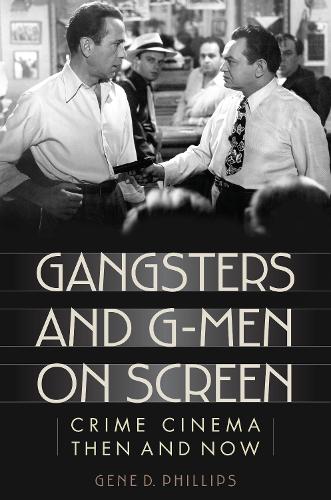
Gangsters and G-Men on Screen: Crime Cinema Then and Now
(Hardback)
Publishing Details
Gangsters and G-Men on Screen: Crime Cinema Then and Now
By (Author) Gene D. Phillips
Bloomsbury Publishing PLC
Rowman & Littlefield Publishers
26th September 2014
United States
Classifications
General
Non Fiction
791.436556
Physical Properties
Hardback
204
Width 163mm, Height 231mm, Spine 20mm
413g
Description
While the gangster film may have enjoyed its heyday in the 1930s and 40s, it has remained a movie staple for almost as long as cinema has existed. From the early films of Humphrey Bogart, James Cagney, and Edward G. Robinson to modern versions like Bugsy, Public Enemies, and Gangster Squad, such films capture the brutality of mobs and their leaders. In Gangsters and G-Men on Screen: Crime Cinema Then and Now, Gene D. Phillips revisits some of the most popular and iconic representations of the genre. While this volume offers new perspectives on some established classicsusual suspects like Little Caesar, Bonnie and Clyde, and The Godfather Part IIPhillips also calls attention to some of the unheralded but no less worthy films and filmmakers that represent the genre. Expanding the viewers notion of what constitutes a gangster film, Phillips offers such unusual choices as You Only Live Once, Key Largo, The Lady from Shanghai, and even the 1949 version of The Great Gatsby. Also included in this examination are more recent ventures, such as modern classics The Grifters and Martin Scorseses The Departed. In his analyses, Phillips draws on a number of sources, including personal interviews with directors and other artists and technicians associated with the films he discusses. Of interest to film historians and scholars, Gangsters and G-Men on Screen will also appeal to anyone who wants to better understand the films that represent an important contribution to crime cinema.
Reviews
Heres a broad-ranging survey of movies about gangsters and government agents (G-men), starting with the first, D. W. Griffiths The Musketeers of Pig Alley (1912), and ending with recent offerings like Public Enemies and Gangster Squad. There are, of course, many well-known movies hereLittle Caesar, the original Scarface, Bonnie and Clyde, The Untouchables, The Godfatherbut the author also introduces us to a lot of films and facts that are likely to be unfamiliar. For example, did you know that the first true 'talkie' wasnt 1927s The Jazz Singer, which only had one scene with audible dialogue, but rather Lights of New York, a 1928 gangster movie Did you know that one of the most controversial gangster pics of the late 1940s bore the sweetly delicate title of No Orchids for Miss Blandish Whether youre a longtime fan of gangster films or relatively new to the genre, this comprehensive and very enjoyable book has something for you. * Booklist *
Phillips analyzes 24 gangster films from the silent era to Gangster Squad (2013), showing how and why the style of these films changed. He focuses on the development of the films from their first conception or source to the ultimate film, and he details the early struggles in bringing some crime films to the public due to opposition from film industry censors and regional censors. In addition, he notes changes in the scripts and comments on directors, producers, and actors. He also looks at the critical reception given to the films. Phillips's revealing observations about films and actors were in part gathered from interviews with famous directorse.g., John Huston, Martin Scorsese, and Fritz Lang, to cite just three. . . .Phillipss prose is readable, and the scholarly apparatus is ample. Summing Up: Recommended. Lower-division undergraduates, general readers. * CHOICE *
Gangsters and G-Men on Screen is a brief anthology of some of the major gangster movies, together with a short plot synopsis and...extra information on production, original story, shooting location and directors. . . .For newcomers to the genre...it is a good introduction. * Popcultureshelf.com *
Author Bio
Gene D. Phillips, SJ, is the author of several works on film and literature, including Beyond the Epic: The Life and Films of David Lean, Some Like It Wilder: The Life and Controversial Films of Billy Wilder, and Out of the Shadows: Expanding the Canon of Classic Film Noir (Scarecrow, 2011). He is the coauthor of The Francis Ford Coppola Encyclopedia (Scarecrow, 2010).
